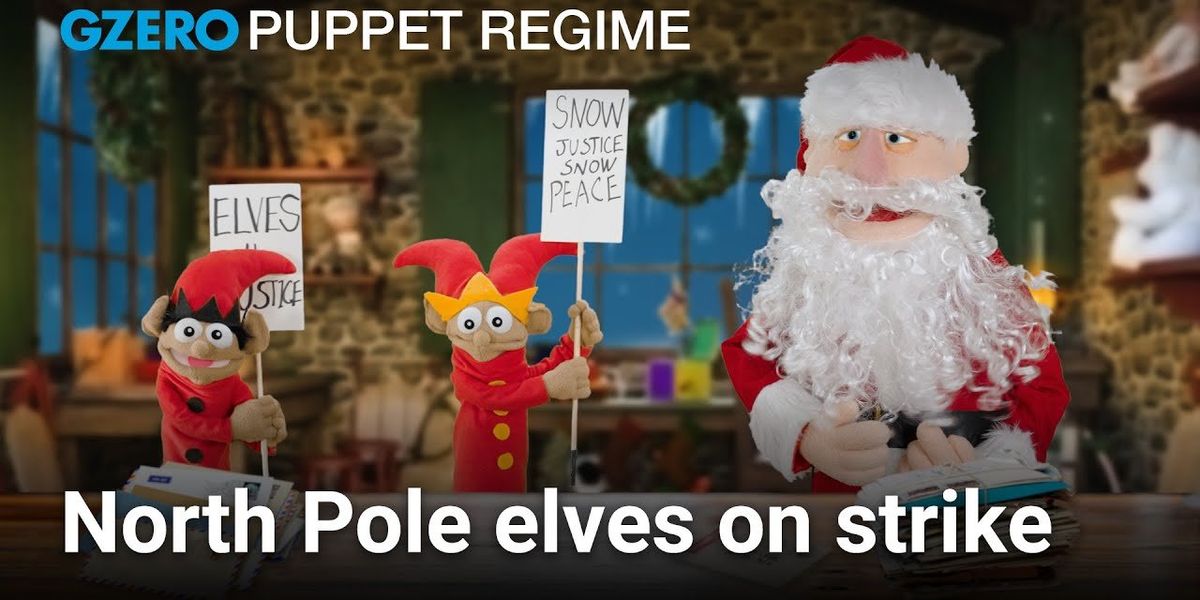Trending Now
We have updated our Privacy Policy and Terms of Use for Eurasia Group and its affiliates, including GZERO Media, to clarify the types of data we collect, how we collect it, how we use data and with whom we share data. By using our website you consent to our Terms and Conditions and Privacy Policy, including the transfer of your personal data to the United States from your country of residence, and our use of cookies described in our Cookie Policy.
{{ subpage.title }}
A strike by the International Longshoremen's Association, the union that represents 85,000 dockworkers, could shut down key port facilities in Newark and Elizabeth.
Dockworker strike brings chaos to dozens of US ports
Dockworker strike brings chaos to dozens of US ports
Traffic at East and Gulf Coast ports is set to plummet thanks to an overnight strike by the International Longshoremen’s Association. The union's 45,000 port workers launched a massive strike at midnight, halting operations at dozens of ports stretching from Maine to Texas.
The port workers have been demanding better pay and benefits and guarantees that automated machinery won’t replace their jobs. The ILA warned that if no agreement were reached with the US Maritime Alliance, the group representing employers, its members would walk off the job at 12:01 a.m. on Tuesday.
The strike will impact nearly half of all US sea-borne imports and as much as 68% of containerized exports — everything from seafood, electronics, and pharmaceuticals, to cars and parts, and even some fruits.
Joe Biden could use the Taft-Hartley Act to intervene in the labor dispute. “Invoking the act might prove enticing to protect national and economic security,” says Jeremy Slater, a trade and supply chains expert at Eurasia Group. But Biden is unlikely to do so in this case, Slater says, “because it essentially undercuts labor rights by forcing negotiations and prohibiting collective striking – not great optics for a pro-labor administration.”
“The knock-on effects from a disruption would compound with every day offline, with a two-week strike necessitating recovery efforts into 2025 by some estimates,” Slater warns.
Sean O’Brien, President of the International Brotherhood of Teamsters speaks during the first day of the Republican National Convention.
Union bosses blast Trump
Sean O’Brien, president of the International Brotherhood of Teamsters, one of America’s largest trade unions, is furious with Donald Trump. During the GOP nominee’s Monday X-space interview with Elon Musk, Trump praised Musk’s willingness to fire workers who threaten to strike. “You’re the greatest cutter,” Trump told Musk. “You walk in and say, ‘You want to quit?’ … That’s OK. You’re all gone.'”
On Tuesday, O’Brien responded: “Firing workers for organizing, striking, and exercising their rights as Americans is economic terrorism.” The United Auto Workers union, meanwhile, wants a federal labor rights investigation of the comments by Musk and Trump.
In years past, a union boss blasting a GOP presidential candidate wouldn’t surprise anyone. But this is the same Sean O’Brien that Trump warmly welcomed to July’s Republican National Convention, where the union boss accused business leaders of “waging a war against American workers.”
Trump’s pro-manufacturing, anti-immigration messaging has resonated with rank-and-file union voters since 2016, even if union bosses still lean Democrat. All the largest American labor unions have endorsed Kamala Harris, except O’Brien’s Teamsters, which hasn’t endorsed anyone. Will Trump’s loose talk with a fellow one-percenter hurt him on the factory floor?Top 10 game changers of 2023
Whether you win or lose, in politics it is still how you play the game that matters. This year, several global players not only played the game, but they changed it in significant and surprising ways. Join us as we revisit some of the most pivotal moments, figures, and trends of the year in geopolitics.
1. Welcome to the AI era
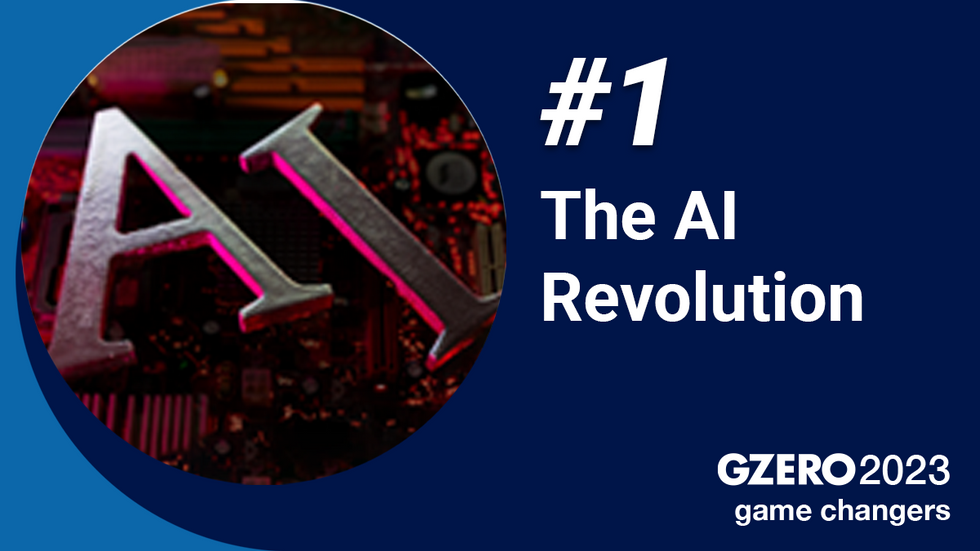
The intelligence may be artificial, but the political stakes are real. Geeks have quietly been developing AI for years, but it wasn’t until the release of ChatGPT late last year that everyone became fully aware of and spooked by the technology’s immense power. It promises to make our societies more efficient, while also threatening to eliminate jobs and undermine trust in institutions, elections, and media (deepfakes anyone?). Throughout 2023, the most powerful governments in the world began racing to find regulatory balances for AI that decrease risks without stifling innovation. The game has changed: 2023 was just the start.
2. The Mugshot
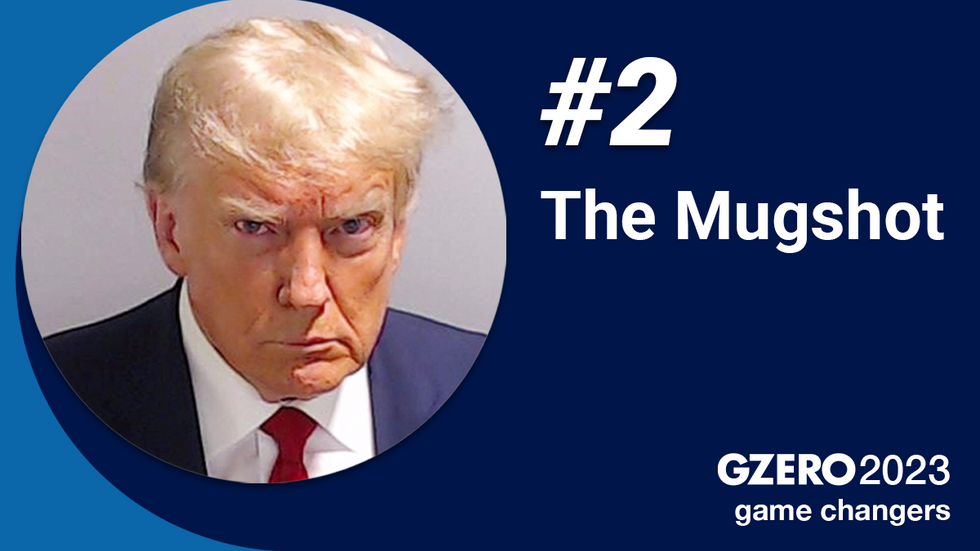
You would think that a twice-impeached former president facing multiple indictments would have almost no shot at the White House. But Donald Trump, the first ex-president to be criminally indicted in US history, remains an enigma in American politics. Rather than undermining his 2024 campaign, Trump’s legal woes seem to have given him major momentum. His mugshot from Georgia played a particularly big role in bolstering his campaign – helping the former president raise millions. Trump ends 2023 far ahead of the remaining GOP contenders – without even participating in presidential debates – and he’s also leading President Joe Biden in the polls.
3. Russian trenches
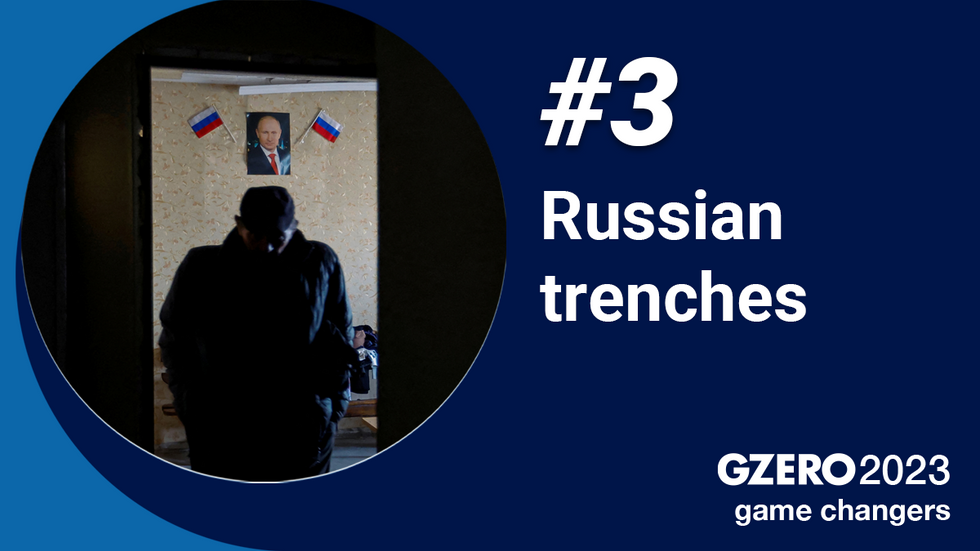
In 2023, Ukraine launched a counteroffensive it hoped would score major gains against Russian invaders and persuade American and European backers that their military and financial investments could help Ukraine win the war. But Russia’s ability to entrench its troops behind heavily fortified barriers frustrated Ukraine’s plans, and Russian forces still occupy 18% of Ukraine’s territory. The war grinds on, and Vladimir Putin is now more confident than ever that Russia can outlast Western support for Ukraine.
4. Modi’s moment

During the pandemic, and then as Western sanctions against Russia pushed global food and fuel prices higher, the world’s wealthy democracies and developing countries of the Global South grew further apart on important issues. No one did more to bridge that gap in 2023 than India’s Prime Minister Narendra Modi. By improving India’s relationship with the G7 and through his leadership of the G20 this year, Modi brokered practical compromises on issues like climate policy and debt. Even controversies over the murder of an activist in Canada and a suspected plot against another in the US didn’t much dent Modi's standing with Western powers that increasingly see him as an important ally against China.
5. American Unions – strong again?
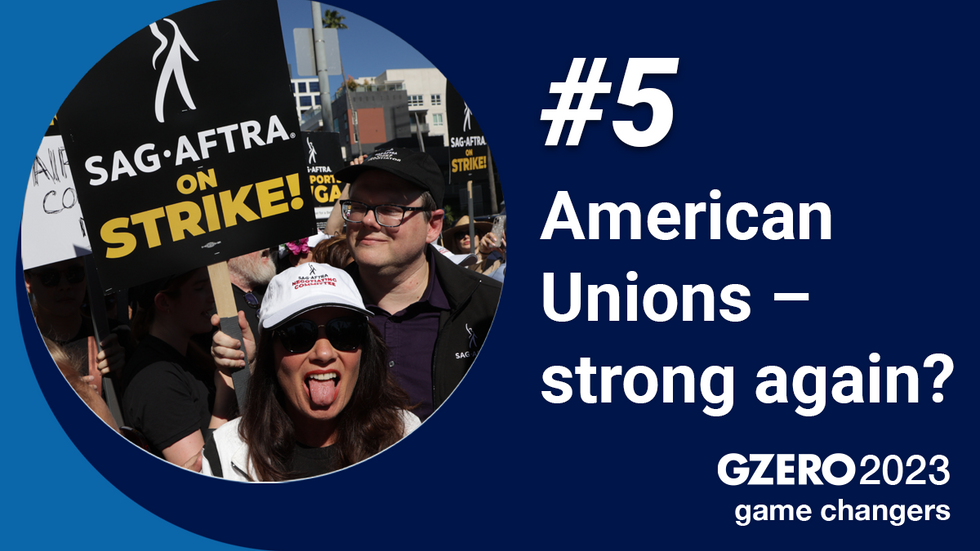
US unions flexed in 2023. Striking autoworkers won concessions from Big Auto and even drew a US president to the picket lines for the first time. Actors and writers' guilds shut down Hollywood for months, and the Teamsters reached a deal with UPS to avoid crippling 6% of the US economy. Overall, nearly half a million workers went on strike this year, nearly eight times as many as in 2021. Non-union employment is still expanding faster, yes, but organized labor has muscled its way back into the political conversation, and popular support for unions is near highs not seen since the 1960s.
6. Hamas
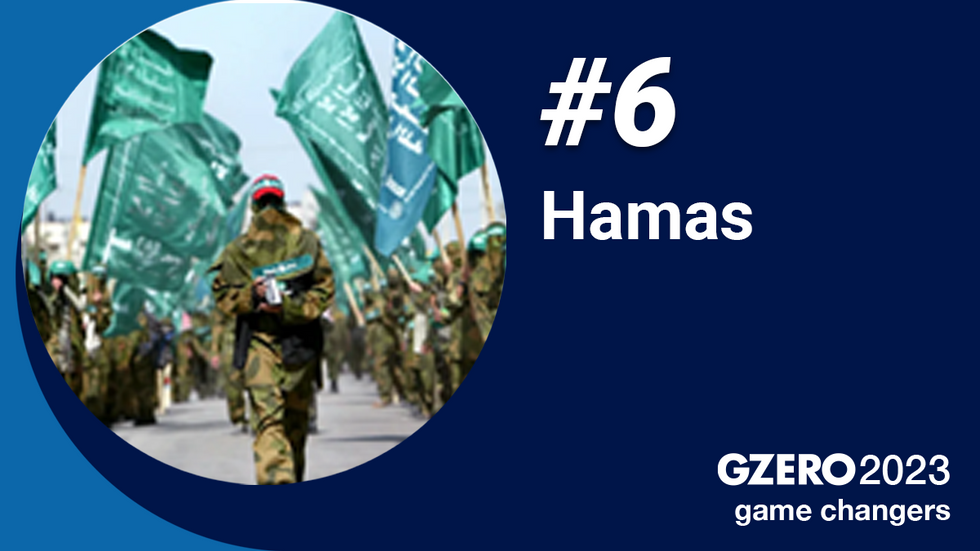
Until the evening of Oct. 6, 2023, an increasingly right-wing Israel looked like it was able to contain Hamas in the Gaza Strip, deepen its illegal occupation of the West Bank with impunity, and still move towards normalizing ties with the Arab world’s most formidable powers. The plight and aspirations of the Palestinians, meanwhile, had fallen almost entirely out of the global spotlight. You already know what happened next.
7. MBS
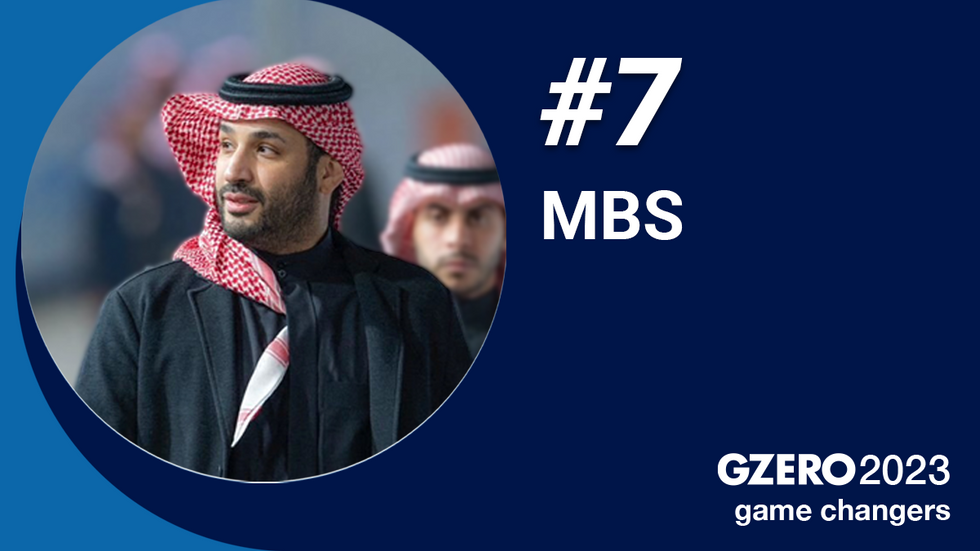
A few years back, Jamal Khashoggi’s brutal murder was seemingly all anyone talked about when they mentioned Saudi Crown Prince Mohammed bin Salman, aka MBS. But the oil-rich kingdom’s investments in popular sports – primarily soccer and golf – have shifted the conversation away from his acts of impunity and his country’s record of human rights abuses. The Saudi soccer league snatched up some of the world’s top players in 2023 after roping in superstar Cristiano Ronaldo, disrupting the status quo in a sport long dominated by Europe. Critics say MBS is “sportswashing” to distract from various other controversies, but he doesn’t seem to care as long as it helps the kingdom increase its GDP and become a top tourist destination.
8. Power Barbie
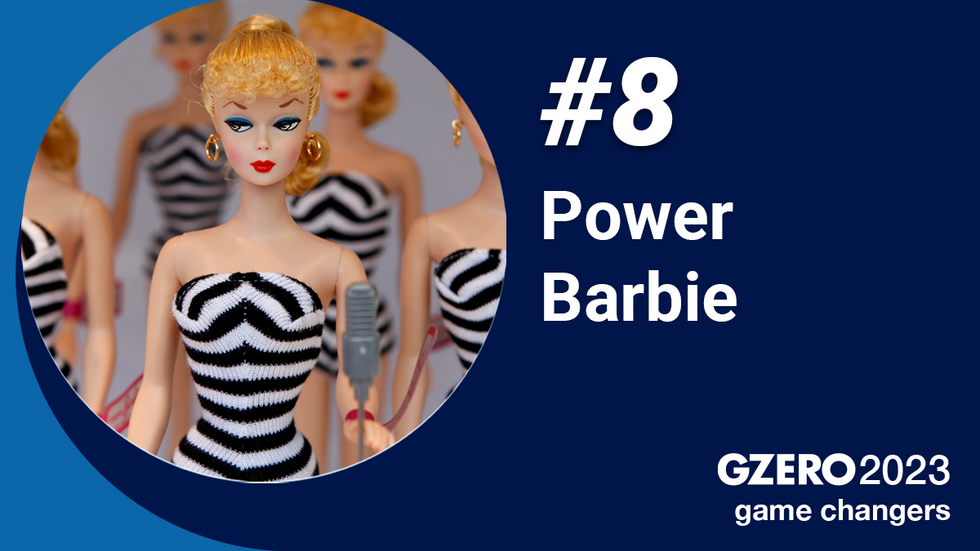
In the decades since 1945, when Ruth Handler first decided to make a doll that encouraged pursuits beyond motherhood, Barbie had strayed from its feminist origins. But director Greta Gerwig rediscovered them with “Barbie,” a global cinematic sensation in which Barbie pushes Ken aside and pursues her own ambitions. Speaking of ambitions, the film made Gerwig the first woman to direct a film surpassing $1 billion at the box office worldwide.
9. Giorgia Meloni
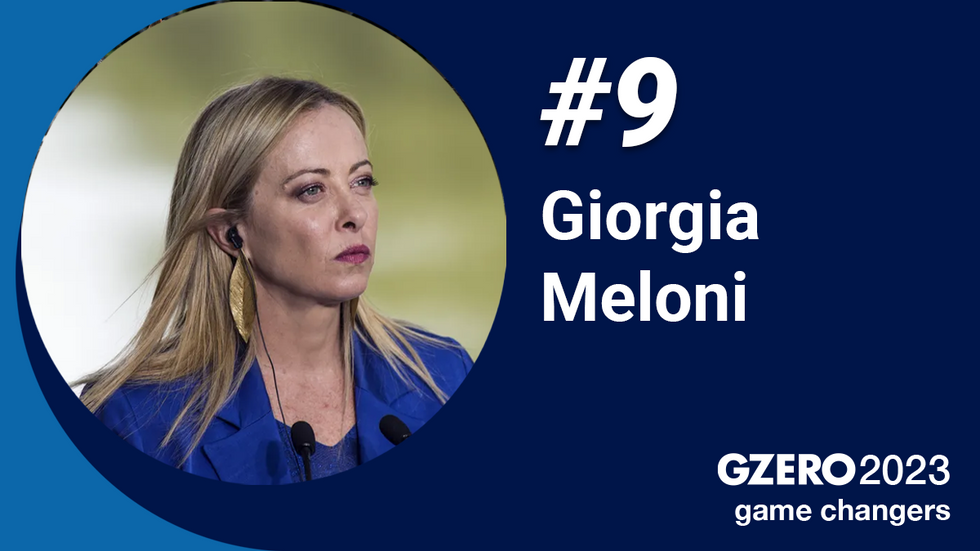
Meloni was a relative unknown on the international stage when Italian voters put her far-right Fratelli d’Italia Party in power late last year, triggering anxieties about the EU’s third-largest economy becoming something like Hungary on steroids: isolated and a thorn in Brussels’ side. Instead, Meloni’s eager embrace of the EU and Ukraine ingratiated her with EU leaders — who in turn have been more open to listening to her ideas on tightening migration policy. It’s a new, electable model for far-right leaders in a Western Europe increasingly invested in the EU but worried about immigration.
10. China owes big
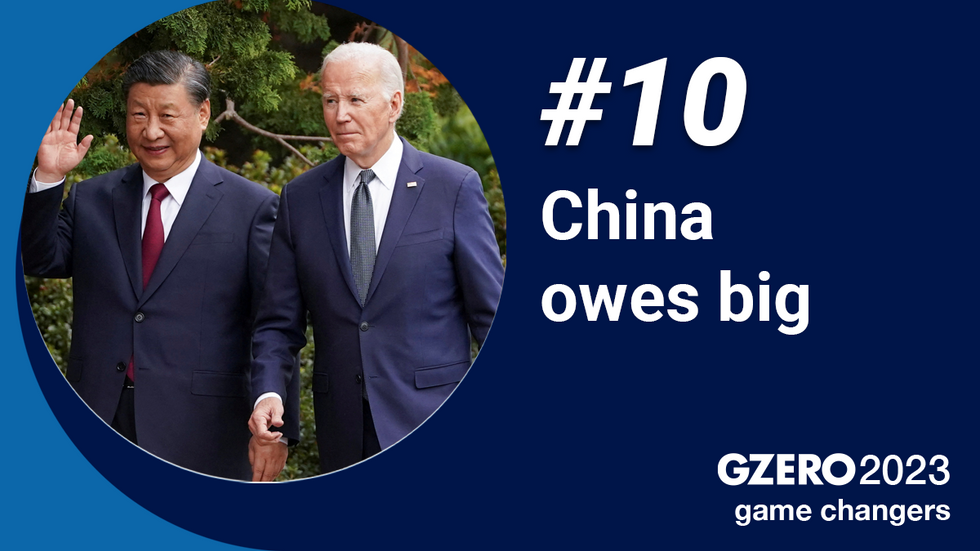
China’s booming economy defined the geopolitical trajectory of the 2010s, but 2023 looks like the year the world began to wonder and worry whether the engine was finally running out of steam. Beijing’s efforts to rein in a staggering debt-to-GDP ratio of 272% have caused knock-on effects ranging from the property market, where two-thirds of Chinese household wealth is invested, to low youth employment, right down to the balance sheets of local governments. It constrained economic growth in 2023, causing global concern about the health of the world’s second-largest economy, — and even seemed to force Xi Jinping to take a more conciliatory approach in relations with the US.
North Pole Elves on strike!
When Santa's elves go on strike for better working conditions, St Nick unwraps an awful truth bomb for them.
Watch more PUPPET REGIME!
Subscribe to GZERO Media's YouTube channel to get notifications when new videos are published.
The world of AI in 2024
2. Labor tensions: The acceleration of AI will continue to reshape industries, automating jobs and displacing workers. That will lead to widespread tension in various sectors of the economy. Union leaders could make AI the centerpiece of their strikes, and you might hear a lot of talk about “reskilling” workers on the lips of lawmakers heading into the 2024 election. This time it’s sure to work …
3. Copyright clarity: We don’t really know how AI models are trained, but we know they’re at least partially trained on unlicensed copyrighted material. Clarity is coming in Europe: The forthcoming AI Act mandates some transparency about training data. But in the US, where regulation is sparse, the courts are considering a big legal question about whether using copyrighted material as training data violates the law. At issue is whether the output is “transformative enough.” The answer to this legal question has extremely high stakes. Look for authors and artists to keep suing. But also look for companies, under pressure from lawmakers, to start opening up about how their systems are trained, whether copyrighted material is used, and why they think the stuff their models spit out does not constitute copyright infringement. We at GZERO aren’t holding our breath for writers' royalties (but we’d sure take ’em).
4. A big new law in Europe: The European Union’s AI Act is set to become law in the spring of 2024. Of course, lawmakers could falter before hitting the finish line, but an agreement this month made that unlikely. What’s ahead: The EU just held the first of 11 sessions to hammer out the details of the law, which will lead to a “four-column document” by February, reconciling proposals from the three EU legislative bodies. Only after that will country representatives vote to finalize the act. But this landmark law won’t have teeth in 2024 even if everything goes to plan because there’s a 12-month grace period for companies to comply. It’s all hurry up and wait.
5. The hype cycle continues: Major investment in AI won’t be a flash in the pan for 2023. With hints of lower interest rates, and still-palpable interest in AI from tech investors hungry for massive returns, expect the billion-dollar valuations, IPOs, mergers and acquisitions, and the big-moneyed investment from top tech firms in startups all to accelerate.
6. Congress does something: The US Congress does more bickering than lawmaking today. But there’s real political will to not get left behind on AI regulation. Lawmakers have been regularly discussing AI, grilling its corporate leaders, and brainstorming ideas for governance. They’ve proposed removing red tape for chipmakers, mandating disclosures for AI-generated political ads, and even considered a “light-touch” law-making AI developers self-certify for safety. It’s not necessarily likely that the US will pass something sprawling like the EU’s AI Act, but Congress will likely pass something about AI in the coming year. More than 50 different AI-related bills have been introduced since the 118th Congress began last year, but none have passed through either house of Congress.
7. Antitrust comes for AI: Regulators are circling. The US government sued Google for allegedly abusing its monopolies in search and advertising technology, Amazon for hurting competition on its e-commerce platform, and Meta for buying dominant market power through its Instagram and WhatsApp acquisitions. That’s the hallmark of current FTC Chair Lina Khan and Justice Department antitrust chief Jonathan Kanter, who have been set on enforcing antitrust law against Big Tech. And that fervor is likely to hit AI in 2024. There’s lots of political will to use antitrust law in the UK and Europe, which means scrutiny will soon come to AI. In fact, it’s already here. The FTC and the UK’s Competition and Markets Authority are reportedly probing Microsoft’s investment into OpenAI – it’s not a full-fledged investigation yet, but in 2024 antitrust regulators will be watching AI very closely.
8. Election problems: In 2024, an unprecedented number of countries – some 40-plus – will head to the polls, and many will have their eyes on places like the United States and India for the use of AI in disinformation campaigns ahead of Election Day. There is concern about deepfake technology fueling confusion or contributing to an already-challenging misinformation problem. We’ve already seen deepfake songs impersonating Indian Prime Minister Narendra Modi and videos portraying US President Joe Biden. But what we haven’t seen yet is AI disrupting an election. Will 2024 be the year that AI-generated words, videos, images, and music play a surprising role in elections?
9. New companies you’ve never heard of. By the end of 2024, the top companies in AI may be the same as today: Anthropic, Google, Meta, Microsoft, and OpenAI. But chances are there will be a startup that you've never heard of on the list. Why? Not only is innovation an everyday reality in AI, but investors are excited to fund these projects to reap potential rewards. In the first half of 2023, AI's share of total startup funding in the US more than doubled from 11% to 26% compared to the same period in 2022. That includes household names and challengers you might have already heard of, such as OpenAI ($29 billion) and Anthropic ($5 billion), which had big funding rounds this year. But there are 15 new AI "unicorns" (billion-dollar companies) that could break into the mainstream, including the enterprise AI firm Cohere ($2.2 billion) and the research lab Imbue ($1 billion). Even in a high-interest rate environment, AI startups have fetched big valuations despite still-paltry revenue estimates — at a time when “easy money” has vanished from the broader tech sector. Expecting stasis would be foolish.
10. The real reason Sam Altman was fired: Expect to learn why OpenAI really fired Sam Altman in 2024. It’s perhaps the great mystery in AI, but it can’t remain a secret forever. If anyone knows the answer, please let us know.
2023: The Year of AI
Art: Courtesy of Midjourney
The Trends
1. Chatbot mania: OpenAI brought AI to the masses with ChatGPT. Though it debuted in late 2022, it truly hit its stride this year, especially when it started charging $20 a month in February for access to its latest and greatest version, which was then upgraded with GPT-4 in March. Google also released Bard, Microsoft launched Bing Chat, and the startup Anthropic introduced us to Claude. Each chatbot has its strength: While ChatGPT is strong on creative writing and inductive reasoning, Bing is best used as a replacement for internet search engines, and Bard’s latest upgrade – to its new language model Gemini – strives for commonsense reasoning and logic. Anthropic's Claude rivals ChatGPT for complex tasks like organizing huge chunks of text. For now, ChatGPT is top dog, but the younger pups are nipping at its heels.
2. Regulators ready their lassos: Following years of debate, the European Union finally reached an agreement in December on the scope of its landmark AI Act, the first major regulation for AI models. Next door, the United Kingdom has proceeded with a hands-off approach, more concerned with courting AI firms than reining them in. Rishi Sunak’s Bletchley summit, which produced a voluntary agreement on AI safety, was a political winner for the PM. The US, by contrast, falls somewhere between the UK and Europe in its approach: Months after President Joe Biden secured voluntary commitments from major AI firms to stave off the worst risks from AI, he issued an executive order to start codifying those protections. There’s no forceful regulation on the books yet — but the wheels are finally in motion.
3. The chip race heats up: AI models are nothing without the semiconductors, aka chips, that power them. Making them, however, is difficult and expensive, and there’s always some kind of holdup. The most powerful AI relies on the most powerful graphics chips, like those produced by NVIDIA and AMD. Recently, OpenAI had to halt new signups for the paid version of ChatGPT for a month because it didn’t have enough graphics chips to accommodate new users. The US, fearful of China catching up technologically and using AI for military purposes, has placed strict export controls on the flow of US-made chips, rules that were tightened this fall. For now, the US maintains its major advantage in the chip wars.
The Moments
4. Puffer pontiff: Who says the pope can’t sport a bit of bling? In March, a photo of Pope Francis wearing a long white Balenciaga puffer coat (sells for $4,350), complete with an oversized crucifix necklace, went mega-viral. It was an outfit more befitting of a rap god than the bishop of Rome, and the fake image of the athleisure pope became a seminal example of the ways generative AI can fool people. It was ultimately harmless, but deepfake technology is getting better and better, and experts have long warned that it could cause chaos in fragile political environments, especially around elections. On Dec. 14, the pope, perhaps bothered by the uproar about his fantastical drip, called for an international treaty to ensure the ethical deployment of AI technologies, warning that it could disrupt democracy or enhance already deadly weapons of war.
5. The open letter: In March, a group of AI scientists and researchers called for a six-month pause on all AI development. “Powerful AI systems should be developed only once we are confident that their effects will be positive and their risks will be manageable,” their letter said. It was signed by technology luminaries and corporate leaders like Apple co-founder Steve Wozniak, MIT professor Max Tegmark, investor Ian Hogarth (who now leads the UK’s AI task force), and Elon Musk (who notably then launched his own AI company). Of course, development wasn’t stymied, but the letter did send a message that there are real and present dangers to the unmitigated development of artificial intelligence. They could have just watched “The Terminator” if you ask me.
6. The Hollywood strike: Actors and writers hit the picket lines for months this year, putting many of our favorite shows on ice. The strike was inspired in no small part by threats from the major studios to use AI to replace union labor. At issue for the Screen Actors Guild was the use of AI to digitally replicate union talent without compensation, while the Writers Guild was more concerned with the use of AI writing tools to shrink writers’ rooms and automate their work. Instead of banning the use of AI, however, both guilds struck deals with the studios that effectively ensure they don’t lose work or money because of the advent of AI. Digital replicas are okay, for example, if the actor is properly compensated.
7. OpenAI’s blowup: What in the world happened at OpenAI? The company’s nonprofit board of directors in late November suddenly and inexplicably fired Sam Altman, the face of the company and CEO of its for-profit arm, for being dishonest with them. But the board never really explained itself. After a weekend of pressure from Altman, OpenAI’s lead investor Microsoft, and 700 of the 770 employees at OpenAI who threatened to quit and work instead at Microsoft, the board reinstated Altman and some of its members resigned. There are still big questions about what happened, but for a brief moment, the most unstoppable company in tech seemed extremely fragile.
The People
8. Sam Altman: Altman is the face of AI. He helms OpenAI, the company that makes the GPT series of large language models, the chatbot ChatGPT, and the image generator DALL-E. But he has also been the AI whisperer for regulators in the US and around the world. Altman played a hands-on role in calling for regulation – as long as it was the kind he likes, such as government licensing for AI developers – and that’s been effective in helping shape global governance of this emerging technology. Of course, Altman was fired and then reinstated (see above), and that was a never-before-seen drama in Silicon Valley. But the ordeal was so surreal and so shocking because Altman isn’t just the head of the most important company in AI; he’s the poster boy for the entire technology.
9. Jensen Huang: OpenAI might be the most important software company in AI, but NVIDIA rules hardware. Under Huang’s guidance, NVIDIA has gone from a little-known company making graphics cards for computer gamers to one of the most critical semiconductor firms in the world. NVIDIA’s graphics chips, or GPUs, are necessary for high-powered computing operations like training and running AI systems. Sure, there’s competition — the chipmaker AMD has grand ambitions to compete directly on AI-ready graphics chips. But it’s leading an industry with very little supply and a ton of demand. That’s one of the reasons why Huang led NVIDIA to a trillion-dollar valuation this year. He’s not as public a figure as Altman, but his work has proven invaluable this year.
10. Geoffrey Hinton: Known as the “godfather of AI,” Hinton distinguished himself over a long career as one of the most prolific and accomplished researchers of artificial neural networks, a set of technologies that powers machine learning. He even won the Turing Award in 2018 — the most esteemed prize in computer science. But this year, Hinton made headlines in May after quitting his job at Google and citing the risks of unfettered development of AI. A whistleblower of sorts, Hinton’s message is extra potent — because, in many respects, he made the breakthroughs that led to present-day AI.
Elon Musk is seen displayed on a mobile device with the Twitter and X logos in the illustration.
Hard Numbers: xAI's Musk money, Investing in Replicate, Undressing AI, AFL-CIO-Google?, NVIDIA’s big gamble
$40 million: AI startup Replicate raised $40 million last week from investors such as Andreessen Horowitz. The company maintains an extensive library of 25,000 open-source models on its platform, all of which are available for developers to tinker with, including Meta’s large language model LLaMA and Stability AI’s Stable Diffusion 2.0. These open models serve as a counter to proprietary — or closed-source — models like OpenAI’s GPT-4.
24 million: AI has been a major tool for computer-generated nonconsensual pornography — a problem that disproportionately affects women. In September alone, 24 million people visited websites that gave them the ability to “undress” — or “nudify” — people in photographs using machine-learning technology.
12.5 million: Google just announced a partnership with the AFL-CIO, one of the most influential US labor unions representing 12.5 million workers. The goal of the partnership is to start an “open dialogue” about how AI might impact the workforce. Microsoft also committed to providing AI training for AFL-CIO members and agreed to include AI-related language in a union contract covering hundreds of workers at ZeniMax, a video game studio it owns. The language dictates that Microsoft is meant to use AI only to “treat all people fairly.”
35: NVIDIA invested in 35 firms this year as the race for AI dominance heated up, making it the most active large-scale investor in the space. That coincided with a year of staggering growth for the US chipmaker, which saw its stock rise 225% and its market capitalization exceed $1 trillion.A striking member of the union Unifor walks to a picket line
Seaway strike hits both sides of the border
A strike by 361 workers at the St. Lawrence Seaway is impeding trade in Canada and the United States. Workers from five Unifor locals are asking for better pay amid the affordability crisis and have cited recent wins by autoworkers as inspiration.
The walkout, which began Sunday, affects the Seaway system connecting the Great Lakes to the Atlantic, facilitating trade from provinces and states, including the Canadian prairies and US Midwest, as well as Ontario, Quebec, and northern states such as New York.
The range of commodities stalled is vast, including grain, soybeans, barley, iron, steel, cement, stone, oil, petroleum products, and more. With most of the Seaway’s locks and ports closed for business, Bruce Burrows, CEO of the Chamber of Marine Commerce, says the strike will cost the economy upward of CA$100 million a day. Goods are being held up, ships backlogged, and trade shuffled — where possible — to trucks and rail.
The Seaway itself is a major source of revenue and jobs across the US and in Canada, accounting for over 240,000 positions and roughly CA$47 billion a year. US industry is already saying the strike has cost jobs in the country and expressed frustration at the slow bargaining process.
Canadian Labor Minister Seamus O’Reagan is hesitant to consider back-to-work legislation but is pressuring the two sides to reach an agreement on their own at the bargaining table. He says he’s in contact with US Transportation Secretary Pete Buttigieg, whose team is tracking the situation.
A recent strike by port workers in Vancouver lasted nearly five weeks. With harvest season in full swing, much of the produce that would normally be shipped along the St. Lawrence Seaway is at risk. That’s putting increased pressure on both Seaway management and the union, which resume talks on Friday, to strike a deal.
